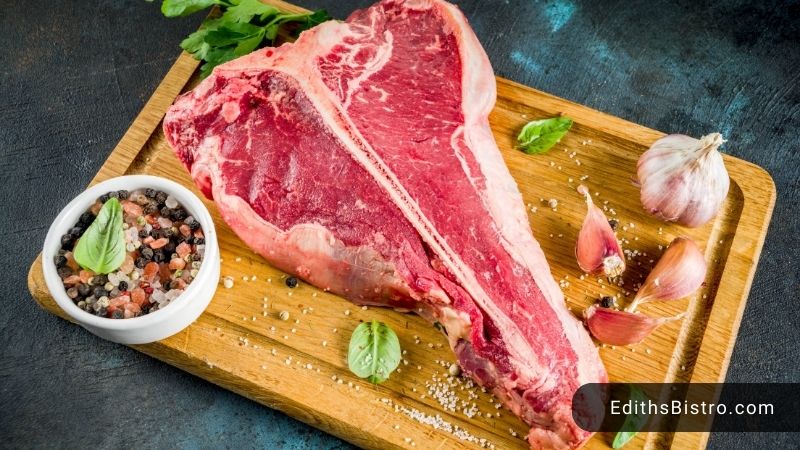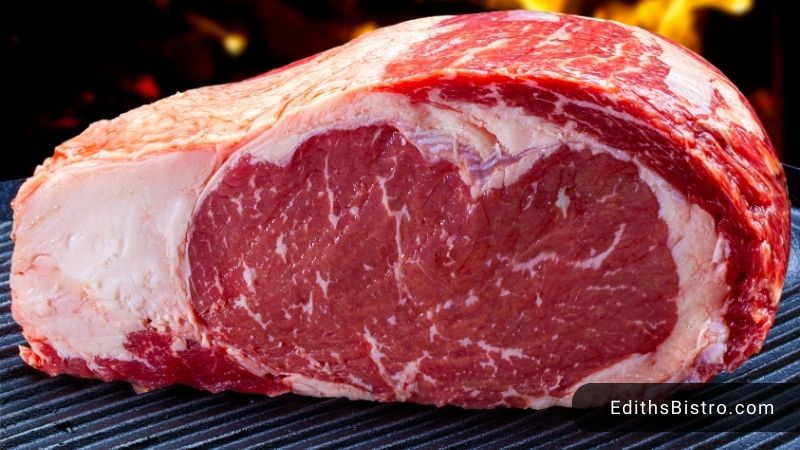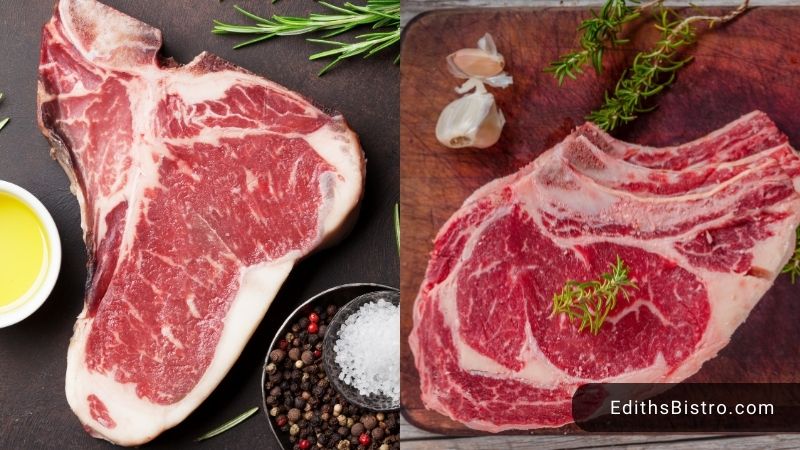Regarding juicy and flavorful cuts of steak, T-bone and ribeye are two popular choices among steak lovers. While both cuts offer delicious taste and tenderness, some key differences between T Bone vs Ribeye make each unique.
T Bone Vs Ribeye
T-bone and ribeye steak have their own unique features. T-bone steak features two distinct cuts—the tenderloin and the strip steak—separated by a T-shaped bone, offering a blend of tenderness and robust flavor. It originates from the short loin area and is moderately priced. Ribeye steak, renowned for its rich marbling and succulence, primarily comes from the rib section, offering a consistently tender texture throughout.
What is T-bone steak?

A T-bone steak is a classic beef cut renowned for its T-shaped bone running through the meat’s center, which includes two distinct cuts:
- Tenderloin: One side of the T-bone features the tenderloin, known for its unmatched tenderness and mild flavor. It ranks among the most tender beef cuts, prized for its velvety texture.
- Strip Steak: On the opposite side of the T-bone lies the strip steak, also called the New York or Kansas City strip. This portion offers a robust, beefy flavor with a slightly firmer texture than the tenderloin.
T-bone steaks are sourced from the cow’s short loin region, typically between the rib and sirloin areas. This positioning grants them a harmonious blend of tenderness and flavor, making them a beloved choice for grilling or pan-searing.
When cooked to perfection, T-bone steaks provide a delightful fusion of textures and flavors within a single cut, making them a preferred selection for steak enthusiasts.
What is ribeye steak?

Ribeye steak, often hailed as one of the most delectable cuts of beef, is prized for its abundant marbling and tenderness. It consists primarily of the longissimus dorsi muscle, frequently referred to as the “eye” of the ribeye.
In addition to the longissimus dorsi, ribeye steaks incorporate the spinalis and complexus muscles. The spinalis, sometimes known as the “ribeye cap,” forms a well-marbled outer layer of the steak, while the complexus is a smaller muscle at the ribeye’s front.
These steaks originate from the upper rib cage region, spanning approximately between the sixth and twelfth ribs of the cattle. The marbling of fat throughout the meat contributes to its juiciness and imparts a delightful flavor.
Ribeye steaks are renowned for their versatility and are suitable for various cooking methods, including grilling, pan-searing, or broiling.
The key differences between T-bone and ribeye steak
Ribeye and T-bone steak are two beloved cuts of beef, each distinguished by its own set of characteristics. Let’s explore the key differences between these two flavorful steaks: their origin, taste, texture, presentation, fat content, cooking methods, pricing, nutritional factors, and famous dishes.
| Characteristics | T-bone steak | Ribeye steak |
|---|---|---|
| Cut and location | This cut hails from the short loin area and boasts its signature T-shaped bone that separates two distinct muscles: the larger strip steak (often called the New York strip) and the smaller tenderloin steak. | As the name suggests, ribeye steak is sourced from the rib section of the cow, primarily featuring the longissimus dorsi muscle. Depending on the cut, it may also contain the spinalis and complexus muscles. |
| Flavor and texture | T-bone steaks offer a fusion of flavors because they encompass two different muscles. The strip steak side delivers a robust, beefy taste, while the tenderloin side is milder and exceptionally tender. | Renowned for its rich, beefy flavor, ribeye benefits from the marbling of fat within the muscle, resulting in a consistently tender texture throughout the steak. |
| Presentation | The most distinguishing visual feature of T-bone cuts is the T-shaped bone running through the center of the steak, making it instantly recognizable. | Ribeye steaks are known for their circular or oval shape, along with the marbling of fat within the meat that enhances their appearance. |
| Fat content | T-bone steaks strike a balance with moderate fat content, mainly due to the marbling found in the strip steak portion. | In contrast, ribeye steaks are generously marbled throughout the meat, which contributes to a higher fat content compared to T-bone steaks. |
| Cooking method | T-bone steaks lend themselves well to grilling or pan-searing, allowing the two distinct muscles to be cooked to different levels of doneness, catering to diverse preferences. | Ribeye’s versatility shines as it can be prepared using various cooking methods, such as grilling, pan-searing, or broiling. |
| Famous dishes | T-bone steaks are often associated with classic dishes like T-bone steak with garlic butter or T-bone steak Florentine, showcasing the versatility of this cut. | Ribeye steaks play a prominent role in popular dishes such as Ribeye au Poivre (peppered ribeye), Cowboy Ribeye (bone-in ribeye), and Ribeye with Blue Cheese Butter, highlighting their exceptional flavor. |
| Price | T-bone steaks are often slightly more budget-friendly than ribeyes | It is more expensive than T-bone steak. |
T Bone Vs Ribeye Vs Sirloin
Here is a summarized comparison chart of T bone vs ribeye vs sirloin:
| Characteristics | T-bone steak | Ribeye steak | Sirloin steak |
|---|---|---|---|
| Cut and location | Short loin section | Rib section | Sirloin section |
| Flavor profile | Two flavors in one | Rich and beefy | Beefy |
| Tenderness | High | Highest | Moderate |
| Fat content | Moderate | High | Low |
| Bone content | Bone in | Bone in or boneless | Boneless |
| Cooking method | High heat | High heat | Medium-high heat |
| Price | From $10 to $25 per pound | From $9 to $20 per pound | From $6 to $15 per pound |
T Bone Vs Ribeye Vs Porterhouse
Here is a summarized comparison chart of T bone vs ribeye vs porterhouse:
| Characteristics | T-bone steak | Porterhouse steak | Ribeye steak |
|---|---|---|---|
| Cut and location | Short loin section | Short loin section | Rib section |
| Flavor profile | Two flavors in one | Two flavors in one | Rich and beefy |
| Tenderness | High | High | High |
| Fat content | Moderate | Moderate | High |
| Bone content | Bone in | Bone in | Bone in or boneless |
| Cooking method | Grilling, pan-searing, and broiling | Grilling | Grilling, pan-searing, and broiling |
| Price | From $10 to $25 per pound | From $9 to $20 per pound | From $15 to $40 per pound |
Is T-bone Or Rib Eye Steak Better?

When it comes to T-bone vs. ribeye steak, these cuts offer distinct characteristics to cater to different preferences:
T-Bone steak
- Two-in-One: The T-bone is named after the T-shaped bone that divides it. It includes the strip steak (New York strip) on one side and the tenderloin (filet mignon) on the other, giving you the best of both worlds—rich flavor and tenderness.
- Flavor Variety: This cut combines the robust, beefy taste of the strip steak with the buttery tenderness of the tenderloin, offering a variety of flavors and textures in a single steak.
- Size Matters: T-bone steaks are typically larger and thicker, making them ideal for those with a hearty appetite or for sharing.
Ribeye steak
- Marbling Excellence: Ribeyes are renowned for their high marbling content, contributing to their rich, juicy, and intensely flavorful profile.
- Consistent Texture: With well-distributed fat marbling, ribeye steaks offer a consistent texture throughout, ensuring every bite is succulent and flavorful.
- Flavorful Reputation: Ribeye steaks are often considered one of the most flavorful cuts of beef, making them a favorite among steak enthusiasts.
The choice between T-bone and ribeye ultimately depends on your personal preferences. If you enjoy combining flavors and textures in one steak, a T-bone might be your best steak. On the other hand, if you prioritize rich, consistent marbling and flavor, a ribeye is one of the most excellent types of steak. Both cuts can be prepared to perfection and deliver a delicious steak experience.
FAQs
Is a T-bone better than a ribeye?
Ribeye steak boasts a velvety tenderness, offering a smooth texture perfect for those who prefer leaner cuts. On the other hand, a T-bone steak provides a unique blend of tenderness and flavor, with one side being tender and the other featuring a delightful richness from the marbling. So, if you savor the combination of tenderness and fat, a T-bone steak is your top pick, while if you prefer a leaner option with less fat, ribeye is the ideal choice.
Can ribeye be boneless?
Yes, ribeye steaks are available in boneless versions, providing a convenient option for individuals who prefer a hassle-free dining experience. Boneless ribeye steaks have gained popularity among consumers seeking the rich and indulgent flavor of ribeye without the added complexity of dealing with a bone. This option offers the same succulent and well-marbled meat that ribeye is known for, ensuring a delightful eating experience.
How does the cooking method differ for a T-bone steak?
Like ribeye, T-bone steak is best cooked using high-heat methods like grilling or pan-searing. Cooking T-bone to medium-rare or medium doneness is important for optimal flavor and tenderness.
References:
- Wikipedia – T-bone steak – https://en.wikipedia.org/wiki/T-bone_steak
- Wikipedia – Rib eye steak – https://en.wikipedia.org/wiki/Rib_eye_steak






![What To Pair With Quiche? 25+ Best Dishes [With Pictures]](https://www.edithsbistro.com/wp-content/uploads/2024/04/what-to-pair-with-quiche-160x90.jpg)
